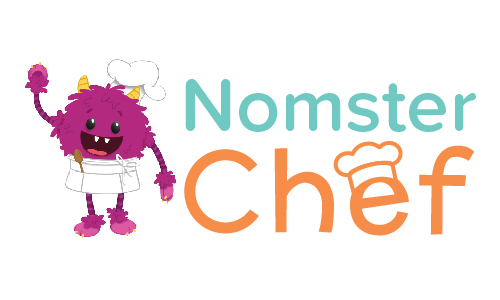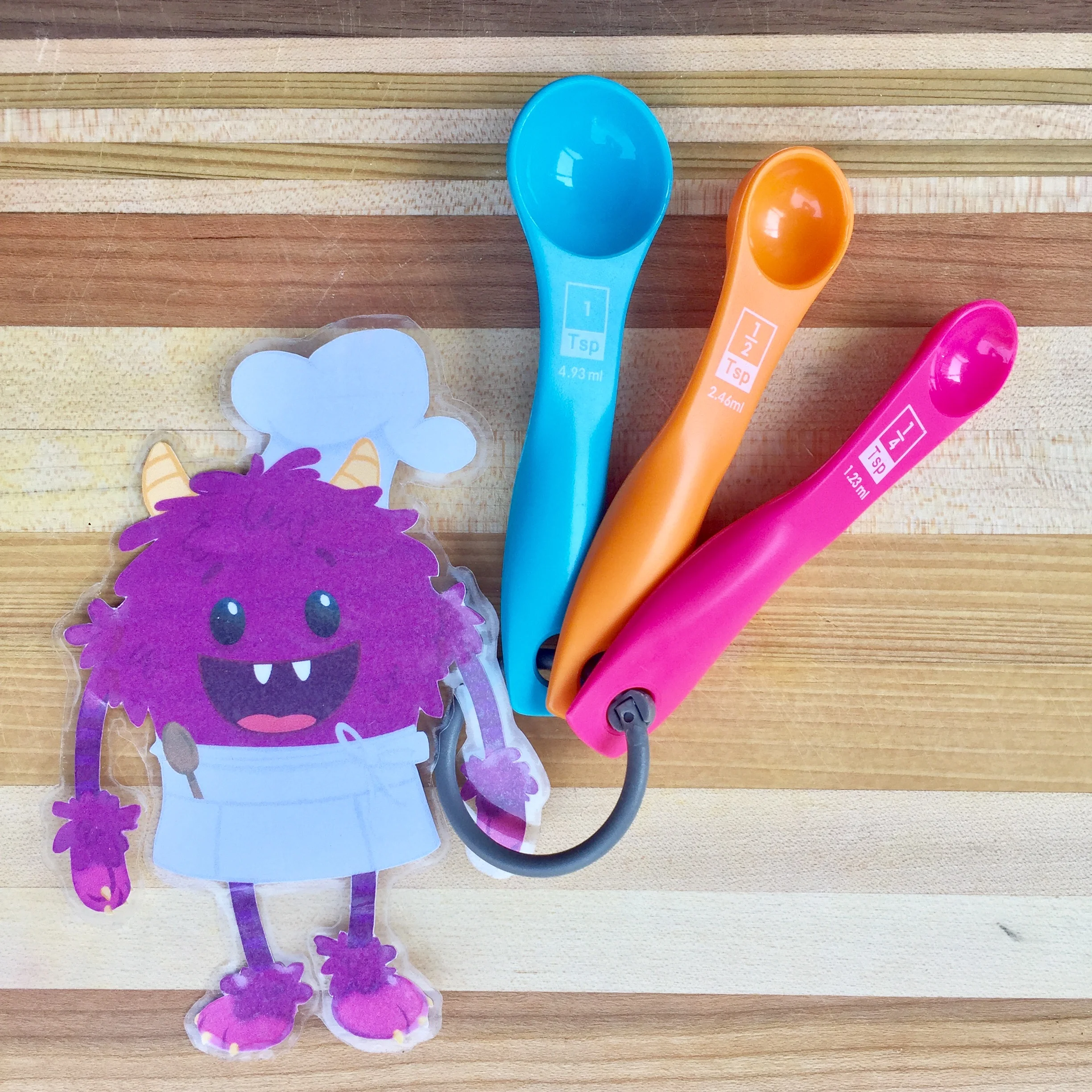Introduction to the Learning Through Cooking series
Most parents know that cooking with kids can be fun, and that is also helps them eat more healthful food, but did you know that young minds can also learning from the process of cooking? With the decline of home economics education, we at Nomster Chef hope to reinvent the wheel on the topic of cooking with little ones. In this blog series, I (a cognitive science psychologist) will explain how the development of cooking skills also helps kids develop life and academic skills.
When kids cook, they practice skills across many disciplines:
Science
Math
Social studies
Problem-solving
Physical/tactile motor skills
Art
Business/financial literacy
First in this series is: Math + Cooking. Kids can learn tons of math concepts from cooking, but to begin, I’ll touch on some early mathematics skills – particularly fractions and food!
Learning through cooking: Fractions
Why it's important for fractions to be in your kitchen
Fractions, for the most part, are not taught in the preschool and very early elementary school years. Building a foundation for this type of mathematical processing can provide an opportunity for children to get a “taste” in fractional thinking. In learning fractions, it is important to provide children real world examples and some rationale behind their thinking from cognitive, developmental and culinary arts perspectives (1).
Food preparation is an opportunity to apply mathematics concepts to real-life situations. Math in the kitchen is a necessity when it comes to measuring, dividing and following instructions.
Visual Models
Children benefit from working with visual fraction models to help develop conceptual understanding of fractions. To have this happen, it helps to analyze one fractional whole at a time. It serves to have children state fractions as part of a whole – in other words being able to state and identify each fractional part as a whole. (2)
As an example: When learning about fourths, use visual models to learn that one out of four partitions is ¼, while three partitions are ¾, and that four fractional partitions make up the whole (4/4 = 1).
How to make visual fraction models while cooking
By using food during cooking, cutting a tortilla into quarter sections can yield an opportunity for math enrichments and well as a tasty snack prep pre-baked oven chips. Children can learn mathematics lessons by dividing recipes to feed a small group. Say, for instance, that children are making squash soup. One soup recipe makes six bowls of soup. But maybe we only need to feed the three people. Caregivers can help children realize that we can divide each ingredient in half and still follow the recipe (3).
Practice makes perfect, and the more often caregivers identify, name and write fractional parts as members of whole entities, the more children will realize the sum of the parts equal a whole.
Measuring with fractions
Our kitchens are often filled with measuring tools. And if you have a well-stocked kitchen, you probably have a series of dry and wet measuring cups. You can use these tools to your advantage.
For instance, if you are working with a recipe that requires 1 cup of oats, you can take the opportunity to teach a mini fraction lesson. Gather the 1 cup measure and pull out the ¼ cup measure as well. Share with your child that 4 of their ¼ measures will equal your 1 cup measure. They have more actions to accomplish in putting in four ¼ cups of oats and gain an understanding that quantity can be represented in more than one way. However, this will yield more dishes to wash, but let’s pick our battles, huh?
Learning by Doing
When thinking about ourselves in the kitchen, we are moving in space and interacting with tools through what is called embodied cognition. A theory that emphasizes mental “simulation and organization of bodily experience” (4).
In other words, grasping, touching, chopping and other haptic actions in the kitchen have a positive effect on the learning experience, because children ARE experiencing the processes of cooking with their hands and other senses. By measuring and dumping ⅓ a cup of beans 3 times to make 1 cup, children have a better understanding of that ⅓ = 3 parts of a whole because they’re acting the math out with their bodies.
Practicing Number Recognition in Fractions
When a parent asks a child to get a ½ teaspoon and says “look for the one with a 1 over a 2,” she’s helping her child to practice recognizing numbers. Children learn what the numeral 1 and 2 look like, and that “a half” is “½.” When children begin to recognize the label on the measuring spoon as both a fraction and a number, it leads to a higher probability of building abstract thinking skills.
Using Child-Centered Language to Support Fraction Learning
Parents who are in the kitchen with kids wanting to cook often lament “oh, to have their energy!” Often, they are curious about the world around themselves and the world around them often asking many, many questions. A majority of the time, they are relating what they learn to themselves (5).
It is important to start their thinking centered on the child, then work outwardly. For example, “YOU are holding the half cup measure, and I (MOMMY/DADDY/CAREGIVER) am holding the quarter cup measure. How many of MINE fit into YOURS?” Again, practice makes perfect and the more often you look to them to use tools in dividing ingredients, the more they will benefit mathematically.
Key Takeaways for supporting fraction learning through cooking
Practice dividing ingredients or meals into smaller pieces so children can see a visual model of fractions (i.e. cutting tortillas into thirds or quarters)
Use measuring cups to show how many smaller cups you need to add up to one bigger cup (i.e. scooping ¼ cup 4 times is the same as scooping 1 cup)
Point out the numerals on the measuring cups/spoons (i.e. “1 over 3 is a one-third cup”)
Explain the math with language that emphasizes the child and at a level they can process
Happy Cooking with Fractions, Nomsters!
OTHER POSTS IN THE "LEARNING THROUGH COOKING" SERIES
Learning through Cooking: Problem-Solving
Citations
(1) Minetola, J., Ziegenfuss, R. G., & Chrisman, J. K. (2013). Teaching young children mathematics. Routledge.
(2) Minetola, J., Ziegenfuss, R. G., & Chrisman, J. K. (2013). Teaching young children mathematics. Routledge.
(3) Krenn, J. L. (2016). Cooking with “App-titude”: Suggestions to Help Educators Promote. Handbook of Research on Mobile Learning in Contemporary Classrooms, 37.
(4) Schwartz, D., Martin, T., & Nasir, N. (2005). Design for knowledge evolution: Towards a prescriptive theory for integrating first- and second-hand knowledge. In P. Gardenfors, P. Johansson, & N. J. Mahwah (Eds.), Cognition, education, and communication technology (pp. 21–54). Mahwah, NJ: Lawrence Erlbaum Associate, Inc.
(5) Minetola, J., Ziegenfuss, R. G., & Chrisman, J. K. (2013). Teaching young children mathematics. Routledge.








